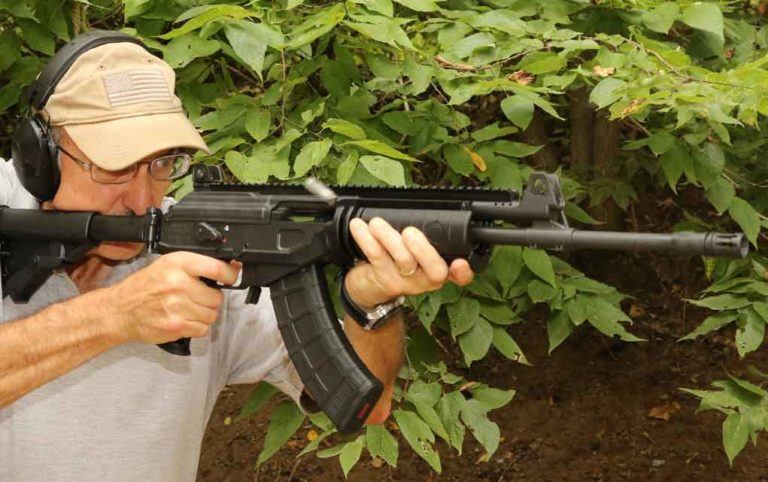
The IWI ACE is an evolution of an evolution, which was then further refined.
- The Galil was the Israelis’ attempt at improving the AK, turning a sharp eye to what the Finns achieved with the Rk 62. The rifle was not well received; in turn IWI designers went back to the drawing board and mustered the Galil ACE.
- Though it has the same gas operation and uses the same magazines as the AK, the ACE has been changed in so many ways it almost defies being called an AK.
- The ACE's charging handle is on the left side of the receiver and stops debris from entering the rifle. Other features include an aperture rear sight and front post, a folding stock and a 16-inch barrel topped with a flash hider.
The Soviets designed and fielded the AK. They spread it across the globe, and when the Israelis clashed with their neighbors, they captured lots and lots of AKs. In the process, the Israelis got tired of the small arms they’d been using, so they naturally took a look at the AK.
As firearms history buffs know, the Israelis started off with WWII surplus. They then rearmed with FALs. By the 1970s, the Israeli Defense Forces, or IDF had become extensively mechanized. Trying to exit an armored personnel carrier while handling an FAL, all 44 inches of it (the folder can be made as “compact” as 33 inches) is a real hassle. The AK is much handier.
So, the IDF put all their effort into making an improved AK. With input they gained from looking at what the Finns did with their Rk 62 the result was the Galil.

Well, the Galil was not exactly a market-dominating product. In fact, it wasn’t even well-received in Israel. Especially the 7.62 version, which ended up nearly as long as, and heavier than, an American M14. The power it provided wasn’t worth the hassle of hauling it. The IDF ended up issuing M16s by the swarm, and the IWI designers went back to the drawing boards, with the objections of the Galil by end-users ringing in their ears.
The end result was the IWI Galil ACE, in this instance the product number GAR1639.
We’ll make it simple, from now on it will be called the ACE, because that is a fitting name.
The ACE is a product-improved AK-47/Galil chambered in 7.62×39. I have seen a version chambered in 5.56, but it was select-fire, and that isn’t one we can get here in the good old U.S. of A. The same gas operation, using the same magazines as the AK, the ACE has been changed in so many ways it almost defies being called an AK.
First, the charging handle has been moved to the left side of the receiver. Usually, this causes problems in the AK, because the charging handle needs an access slot, and that means a big gap through which debris can enter. IWI designed and installed a dual-hinged spring-loaded cover for this gap.
When the bolt is forward, the cover is pressed up by the springs, covering the gap. When the action cycles, the charging handle presses the cover down against its springs. When the action closes up again, the cover slides up, covering the gap — ta-da, the gap is open only for a moment, when the action is cycling, and the chances of something getting in are so remote as to be unworthy of concern.
And yes, the charging handle reciprocates. On the FAL, it does not. But the charging handle on an AK is many things — it is a charging handle, forward assist, and lever you use to get the action open when you’ve rusted or mudded it shut. It reciprocates.
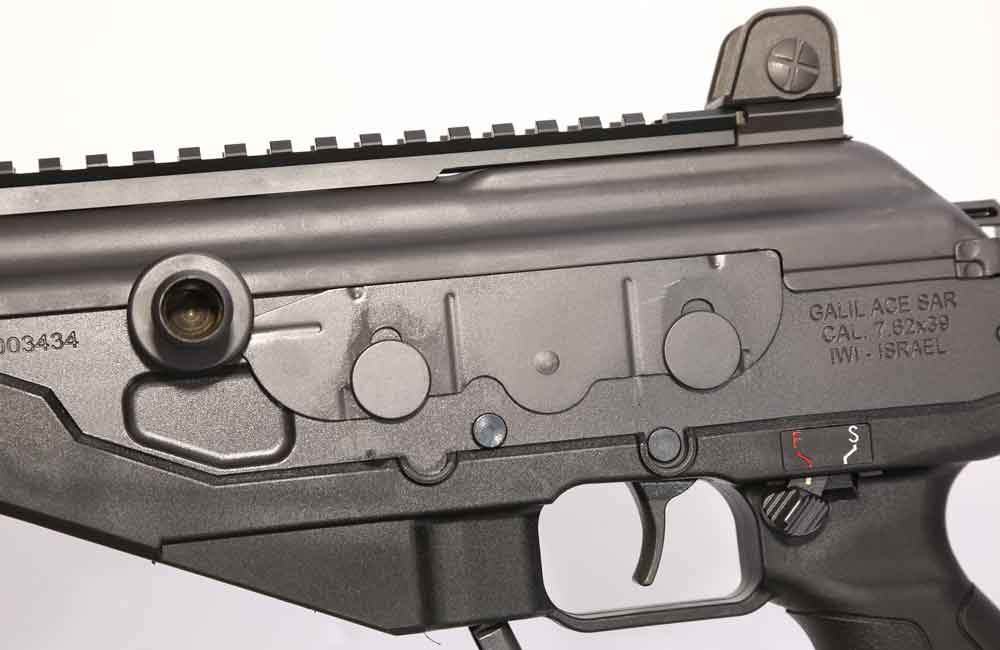
Since the charging handle is on the left, the right side of the carrier would be slick. IWI put a machined recess there, which you can use as a forward assist.
The top cover is tightly fitted to the receiver, with no perceptible wobble. Which is good, because in place of the notch and post of the AK, the sights of the ACE are a proper aperture rear, and a front post. This greatly increases the sight radius, and also improves the eye/brain ability to recognize alignment error.
The rear sight is a flip sight, with two apertures, and each is marked. One is marked “3” and has a pair of tritium cells for night use flanking the aperture, but a bit below it. That’s your 300-meter zero sight. The other one lacks the tritium, and is marked “5.” That’s your 500-meter sight, and if you can use tritium dots on a 500-meter target at night, you have far better vision than any of the rest of us.
On the top cover is a Mil-Std. 1913 rail, commonly miscalled a Picatinny rail. The gas tube also has this rail, at the same level and aligned with it. The top cover rail has a tenon that wedges into the groove in the rear of the gas tube rail, so they are mutually supported. This arrangement provides you with a full-length rail, onto which you can put optics, magnifying or red-dot. You can install lights, lasers, night vision, thermal optics, whatever fits and is found useful and worthy of the weight. Fair warning: the gas tube on an AK can get hot, so you might not want to park something on that part of the rail, if it is heat-sensitive.
The front sight is in the gas block, and the block is aligned so the gas port is vertical, not slanted. The gas block is pinned on with a pair of transverse pins, located below the barrel. This is the way the Finns did it, unlike the Soviets, who commonly pinned above the barrel. Both work though I find I like the looks of the below method more.
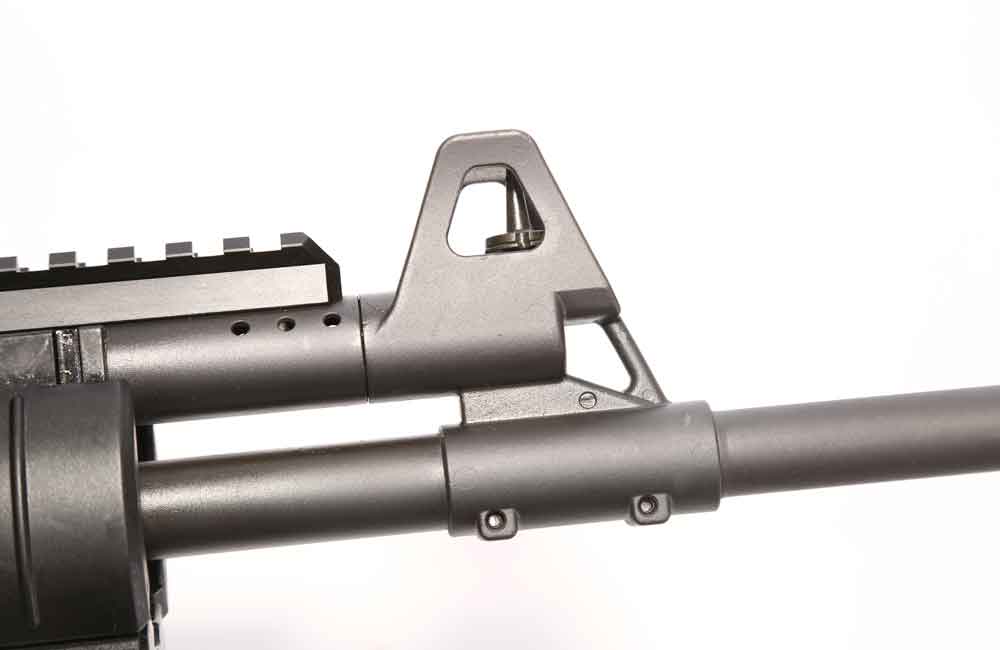
The front sight post is another interesting departure from vanilla-plain AK. The post is tapered, and has a tritium cell in it. How do they keep it facing the shooter, you ask. The post base has two flanges. If you are adjusting the sights for zero, press down the spring-loaded plunger for adjustment, turn the post and check.
Once you get the zero dead-on, depress the plunger only enough to free the top flange, and turn the post cover until the opening for the tritium cell faces the shooter. And the mystery of the low tritium cells on the rear sight is now solved. Since the tritium on the front sight can’t be at the very tip of the sight, but below the tip, the rear cells are also lower, so you’ll be properly aligned. Clever, no?
The sight adjustments are 1 inch at one hundred yards, per click or adjustment notch. Interestingly, the rear sight can be removed from the top cover. I’d hazard a guess that’s to make it easy to replace when it gets dropped by some fumble-fingered recruit.
On the backend, the stock is both adjustable and folding. The adjustments work like the AR — squeeze the lever to unlock it, and slide the buttstock forward or back to the length that is comfortable. Fully shortened (11.85 inches of pull) my nose almost touches the receiver, and the receiver bumps me a bit when I’m firing. I can see the front sight wings through the aperture. Fully back (15.25 inches of pull) the wings are almost but not quite visible outside of the rear sight plate. That’s a lot of adjustment, with five separate stops.
The buttplate is ridged, hard plastic. There is a clip-on cheek piece you can use that allows you to have a proper cheek weld for use with optics.
The stock folds to the right, the ejection port side. It doesn’t interfere with ejection, and doesn’t bind the safety/selector (more on that shortly). The stock locks in place when it is unfolded, so it won’t fold on you when you are using it.
The lock is simple; it is taken directly from the FN design for folding stocks. To unlock and fold, press the stock assembly down toward the ground, against the locking spring. Once the locking latch clears the notch, hinge the stock to the right, toward the ejection port.
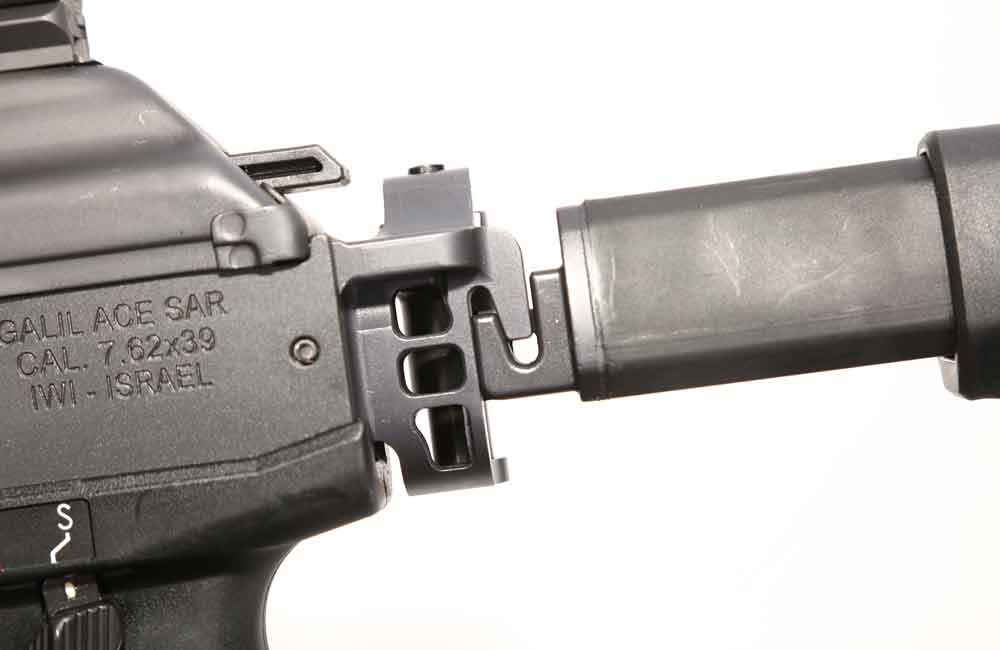
The hinge pin has an angled head, and the angle will let the pin ride up when you fold the stock. The pin will cam down when you force the stock open, but the stock is not mechanically locked while folded. This is clever and correct. You want the stock locked open when you use it as a stock. You do not need the stock locked while folded, because if you want to unfold it you don’t want to be messing around with buttons, levers or other such problems. Just grab the stock and flip it open.
Inside the top cover is the expected carrier and bolt. Getting the cover off can be an adventure. The retaining tab is longer than on a Soviet AK (as on the Galil/Golani), the tight fit of the top cover can make getting the retainer pressed in — and kept in while the cover is lifted — a whole lot of work.
Inside the recoil spring assembly not only has a synthetic impact block (I’m going to try as hard as possible to avoid calling it a shok-buff) but the back of the retainer features a rubber slip pad, or cover. This rides between the retainer assembly and the inside rear of the cover. Interestingly, the parts list describes it as #23, Blocker, Gas Injection. Hmm, never did get gas up the nose from an AK, but OK.
The bolt and carrier come out to the rear and lift up just as with a standard AK, but as you move them you’ll discover an improvement the Israelis added in — the gas tube is not held in with a lever, as on a standard AK, but slides into place on a short set of rails. The top cover holds the gas tube in place. You can take the top off, the bolt and carrier out, and the gas tube off in a matter of seconds with no risk of stabbing yourself with a screwdriver, or gouging the finish.

Inside the milled receiver is a standard two-hook, two-stage trigger, with the disconnector positioned and timed to act as the stop on the second stage.
The safety/selector is a lever on the upper rear right of the receiver, and is not the cover over the ejection port. In fact, there is no cover over the ejection port. If you think it is out of the way and a bit difficult to reach, you’re wrong. Well, those with small hands will find it tough, but the lever is positioned nicely to your trigger finger. But you needn’t fear, there’s one on the left side, just above the pistol grip.
That’s right, IWI has figured out how to not only put a safety lever in two places where you can reach them, but give it the leverage it needs so you can actually move it. It’s a safety you can work without taking your firing grip off of the rifle. The safety on the right side bears against the stock when folded, but the stock does not keep the safety from moving.
Now, “leverage enough” can be a relative thing. I can push the right-hand side lever from Safe to Fire with my trigger finger. However, I cannot push it back to Safe. For that, I have to use my thumb, and the lever on the left side. You may find yours is easier, or your hands stronger, but be aware and remember you have two levers.
The next change is the bottom metal of the receiver or, actually, the bottom polymer. The pistol grip, magazine catch and magazine guide box are all made of a high-strength polymer. This polymer assembly is semi-permanently attached to the receiver, and is not meant to be removed by the user. If you really feel the need, there are a couple of big screws, one in the pistol grip, the other in front of the magazine well that hold it on. I suggest leaving them alone, because there’s nothing good you can do with it off.
You may be looking at the ACE and thinking, “This is nice, but those are some awesomely fat handguards, and there’s no place to mount my light.” Oh, ye of little faith. Notice the buttons on the sides of the handguards? Those are the locking tabs. Press in and the handguard cover slides forward, and off the handguard base. Just like that, you have railed handguards. All three come off at 3, 6 and 9 o’clock. The first person to complain that these are pic rails, and not M-Lok or Keymod, gets slapped.
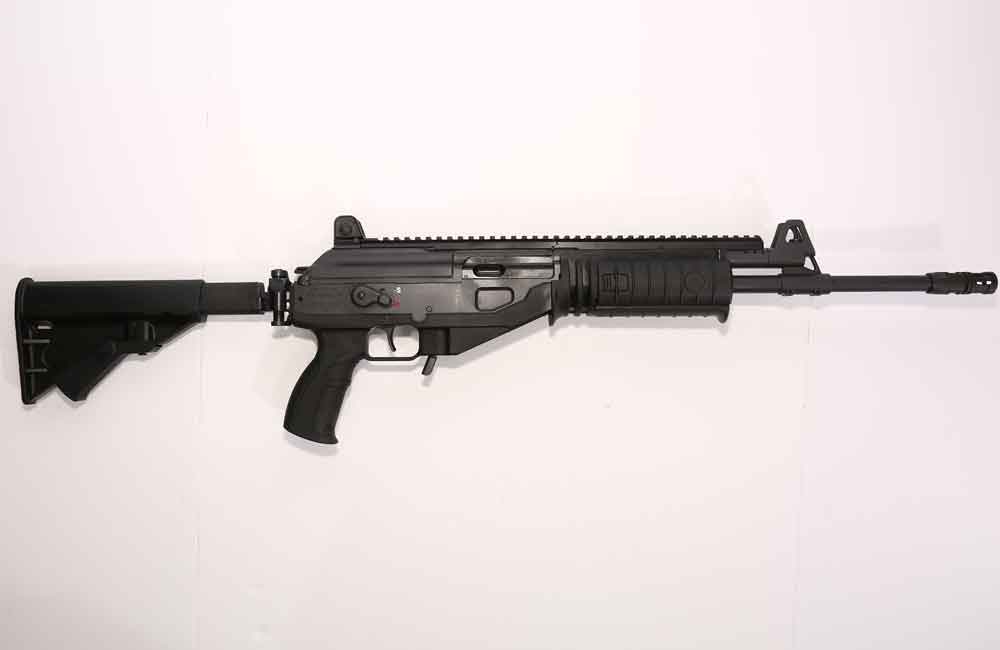
Last, we have the flash hider. It is threaded onto the 16-inch barrel. The barrel is chrome-moly-Vanadium steel, cold hammer forged, and chrome-lined. The flash hider looks a bit long because it uses a lock nut behind it to hold the flash hider in the correct orientation without using crush washers or other delicate tools.
As a design a military armorer can deal with, it is simple and rugged. Suppose a trooper blows his flash hider apart, having clogged it with mud and then firing his rifle. The unit armorer simply uses a pair of open-end wrenches (and the guy in the unit with the biggest hands, to hold the rifle flat on the bench) to loosen the jam nut. He then spins the old parts off, cleans the threads, spins the new ones on, orients the new flash hider correctly, and tightens the jam nut up behind it. He doesn’t even need a vise or other tools.
The last detail is interesting. The ACE comes into the country in a non-922(r) compliant condition. IWI U.S. then installs U.S.-made parts to make it 922(r) compliant. However, they do note that you should use only a U.S.-made magazine. Use of imported magazines may put you in violation of 18 U.S.C. § 922(r). Since they ship it with a Magpul magazine, this seems pretty clear.
They are depending on one, two or all three of the magazine parts to keep the ACE in compliance. OK, just make sure to use U.S.-made magazines. That will be easy. Once Magpul announced their magazines (and Tapco joined the party), I have not bought an imported magazine for the AK since. Actually, except for the period-specific builds, none of my AKs are going to experience anything but a Magpul, Tapco, or other U.S.-made magazine.
Editor's Note: This article is an excerpt from Gun Digest Book of the AK & SKS, Volume II.

Next Step: Get your FREE Printable Target Pack
Enhance your shooting precision with our 62 MOA Targets, perfect for rifles and handguns. Crafted in collaboration with Storm Tactical for accuracy and versatility.
Subscribe to the Gun Digest email newsletter and get your downloadable target pack sent straight to your inbox. Stay updated with the latest firearms info in the industry.

![Best Concealed Carry Guns In 2025 [Field Tested] Wilson Combat EDC X9S 1](https://gundigest.com/wp-content/uploads/Wilson-Combat-EDC-X9S-1-324x160.jpg)


![Best 9mm Carbine: Affordable PCCs [Tested] Ruger Carbine Shooting](https://gundigest.com/wp-content/uploads/Ruger-Carbine-Shooting-100x70.jpg)
![Best AR-15: Top Options Available Today [Field Tested] Harrington and Richardson PSA XM177E2 feature](https://gundigest.com/wp-content/uploads/Harrington-and-Richardson-PSA-XM177E2-feature-100x70.jpg)
